Chapter: 12th Physics : Magnetism and Magnetic Effects of Electric Current
Expression for torque on a current loop placed in a magnetic field
TORQUE ON A CURRENT LOOP
The force on a current
carrying wire in a magnetic field is responsible for the motor operation.
Expression for torque on a current loop placed
in a magnetic field
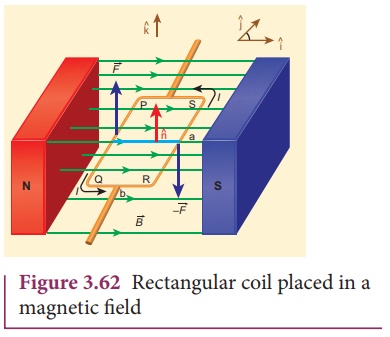
Consider a single rectangular
loop PQRS kept in a uniform magnetic field ![]() . Let a and b
be the length and breadth of the rectangular loop respectively. Let n
^ be the unit vector normal to the plane of the
current loop. This unit vector n ^ completely describes the orientation of the
loop. Let
. Let a and b
be the length and breadth of the rectangular loop respectively. Let n
^ be the unit vector normal to the plane of the
current loop. This unit vector n ^ completely describes the orientation of the
loop. Let ![]() be directed from north pole to south pole of the magnet as
shown in Figure 3.62.
be directed from north pole to south pole of the magnet as
shown in Figure 3.62.
When an electric current
is sent through the loop, the net force acting is zero but there will be net
torque acting on it. For the sake of understanding, we shall consider two
configurations of the loop; (i) unit vector n pointing perpendicular to
the field (ii) unit vector pointing at an angle θ with the field.
(i) when unit vector n is perpendicular to the
field
In the simple configuration, the unit vector n ^ is perpendicular to the field and plane of the loop is lying on xy plane as shown in Figure 3.62. Let the loop be divided into four sections PQ, QR, RS and SP. The Lorentz force on each loop can be calculated as follows:
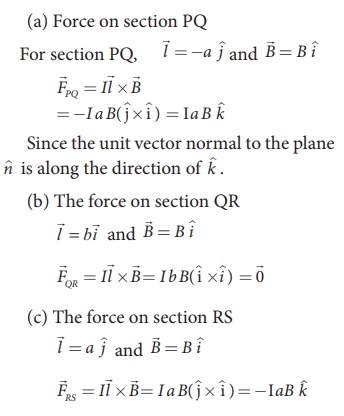
Since, the unit vector normal to the
plane is along the direction of -k^.
(d) The force on section SP

The net force on the rectangular
loop is

Hence, the net force on the
rectangular loop in this configuration is zero. Now let us calculate the net
torque due to these forces about an axis passing through the center

Since, A = ab is the area of the
rectangular loop PQRS, the net torque for this configuration is

When the loop starts
rotating due to this torque, the magnetic field ![]() is no longer
in the plane of the loop. So the above equation is the special case.
is no longer
in the plane of the loop. So the above equation is the special case.
When the loop starts
rotating about z axis due to this torque, the magnetic field ![]() is no longer in the plane of the loop. So the above equation is the special
case.
is no longer in the plane of the loop. So the above equation is the special
case.
(ii) when unit vector n is at an angle θ with the field
In the general case, the
unit normal vector n ^ and magnetic field ![]() is with an angle θ as
shown in Figure 3.63.
is with an angle θ as
shown in Figure 3.63.
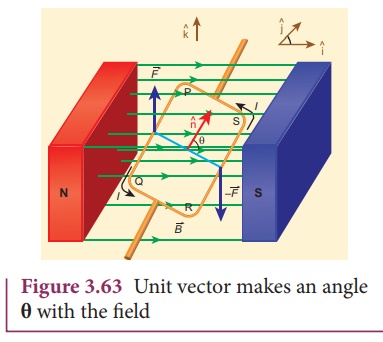
(a) The force on section
PQ

Since, the unit vector
normal to the plane n ^ is along the direction of k ^.
(b) The force on section
QR
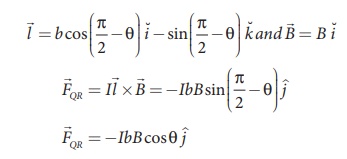
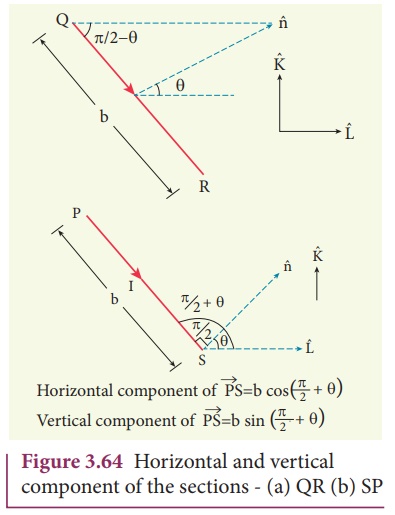
(c) The force on section RS

Since, the unit vector normal to the
plane is along the direction of -k^.
(d) The force on section SP
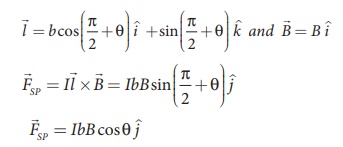
The net force on the rectangular
loop is
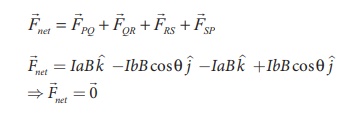
Hence, the net force on the rectangular
loop in this configuration is also zero. Notice that the force on section QR
and SP are not zero here. But, they have equal and
opposite effects, but we assume the loop to be rigid, so no deformation. Hence,
no torque produced by these two sections.
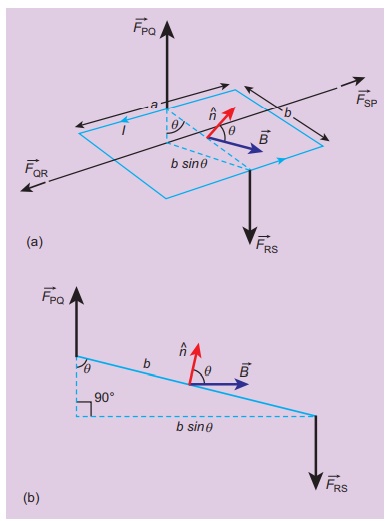
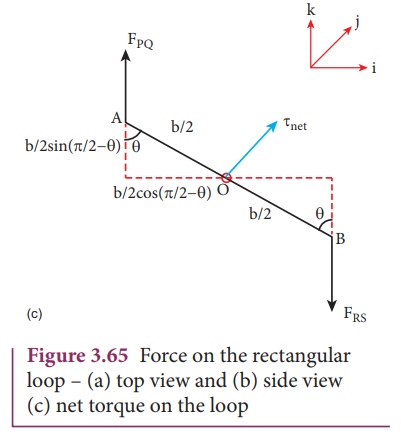
Even though the forces
PQ and RS also are also equal and opposite, they are not collinear. So these
two forces constitute a couple as shown in Figure 3.65 (a). Hence the net
torque produced by these two forces about the axis of the rectangular loop is
given by
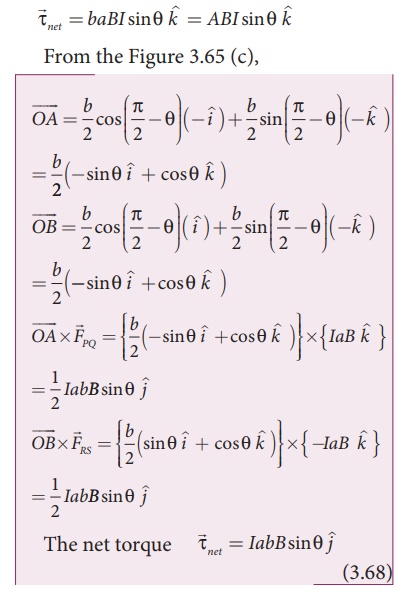
Note that the net torque
is in the positive y direction which tends to rotate the loop in clockwise
direction about the y axis. If the current is passed in the other way
(P→S→R→Q→P), then total torque will point in the negative y direction which
tends to rotate the loop in anticlockwise direction about y axis.
Another important point
is to note that the torque is less in this case compared to earlier case (where
the n^ is perpendicular to the magnetic field ![]() ). It
is because the perpendicular distance is reduced between the forces
). It
is because the perpendicular distance is reduced between the forces ![]() PQ
and
PQ
and ![]() RS in this case.
RS in this case.
The equation (3.68) can
also be rewritten in terms of magnetic dipole moment

This is analogous
expression for torque experienced by electric dipole in the uniform electric
field
 which is given in the Unit 1. (Section 1.4.3)
which is given in the Unit 1. (Section 1.4.3)
Cases:
(a) When θ = 90º, then
the torque on the current loop is maximum which is

Note here ![]() m points
perpendicular to the magnetic field
m points
perpendicular to the magnetic field ![]() . The torque is
maximum in this orientation.
. The torque is
maximum in this orientation.
(b) When θ = 0º or 180 º then the
torque on the current loop is

when θ = 0º ![]() m is parallel to
m is parallel to ![]() and for θ = 180º
and for θ = 180º ![]() m , is anti - parallel to
m , is anti - parallel to ![]() . The torque is zero in these orientations.
. The torque is zero in these orientations.
EXAMPLE 3.28
Consider a circular wire
loop of radius R, mass m kept at rest on a rough surface. Let I be the current
flowing through the loop and ![]() be the magnetic field acting along
horizontal as shown in Figure. Estimate the current I that should be applied so
that one edge of the loop is lifted off the surface?
be the magnetic field acting along
horizontal as shown in Figure. Estimate the current I that should be applied so
that one edge of the loop is lifted off the surface?
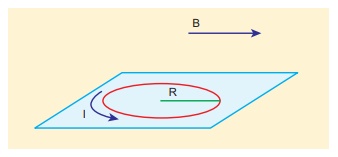
Solution
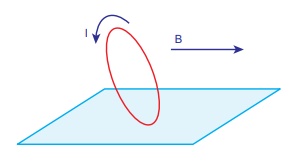
When the current is
passed through the loop, the torque is produced. If the torque acting on the
loop is increased then the loop will start to rotate. The loop will start to
lift if and only if the magnitude of magnetic torque due to current applied
equals to the gravitational torque as shown in Figure
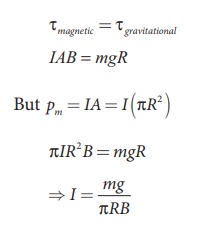
The current estimated using this equation should be applied so that one edge of loop is lifted of the surface.
Related Topics